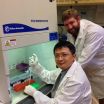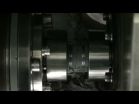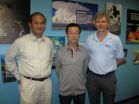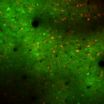(Press-News.org) ASU scientists, together with collaborators from the Chinese Academy of Sciences in Shanghai, have published today, in Nature Structural and Molecular Biology, a first of its kind atomic level look at the enzyme telomerase that may unlock the secrets to the fountain of youth.
Telomeres and the enzyme telomerase have been in the medical news a lot recently due to their connection with aging and cancer. Telomeres are found at the ends of our chromosomes and are stretches of DNA which protect our genetic data, make it possible for cells to divide, and hold some secrets as to how we age –and also how we get cancer.
An analogy can be drawn between telomeres at the end of chromosomes and the plastic tips on shoelaces: the telomeres keep chromosome ends from fraying and sticking to each other, which would destroy or scramble our genetic information.
Each time one of our cells divides its telomeres get shorter. When they get too short, the cell can no longer divide and it becomes inactive or dies. This shortening process is associated with aging, cancer and a higher risk of death. The initial telomere lengths may differ between individuals. Clearly, size matters!
"Telomerase is crucial for telomere maintenance and genome integrity," explains Julian Chen, professor of chemistry and biochemistry at ASU and one of the project's senior authors. "Mutations that disrupt telomerase function have been linked to numerous human diseases that arise from telomere shortening and genome instability."
Chen continues that, "Despite the strong medical applications, the mechanism for telomerase holoenzyme (the most important unit of the telomerase complex) assembly remains poorly understood. We are particularly excited about this research because it provides, for the first time, an atomic level description of the protein-RNA interaction in the vertebrate telomerase complex."
INFORMATION:
The other senior author on the project is professor Ming Lei who has recently relocated from the University of Michigan to Shanghai, China to lead a new National Center for Protein Science (affiliated with the Chinese Academy of Sciences).
The Department of Chemistry and Biochemistry at ASU, in the College of Liberal Arts and Sciences, ranks 6th worldwide for research impact (gauged by the average cites per paper across the department for the decade ending in the 2011 International Year of Chemistry) and in the top eight nationally for research publications in Science and Nature. The department's strong record in interdisciplinary research is also evidenced by its 31st national ranking by the NSF in total and federally financed higher education R&D expenditures in chemistry.
This work was supported by grants from the US National Institutes of Health (RO1GM094450 to J.J.-L.C.), Ministry of Science and Technology of China (2013CB910400 to M.L.), and the Strategic Priority Research Program of the Chinese Academy of Sciences (XDB08010201 to M.L.).
Arizona Sate University scientists take steps to unlock the secrets to the fountain of youth
2014-05-04
ELSE PRESS RELEASES FROM THIS DATE:
Study unveils new approach to treating brittle bone disease
2014-05-04
HOUSTON – (May 4, 2014) – Researchers at Baylor College of Medicine have identified a new approach to treating brittle bone disease, a congenital disorder that results in fragile bones that break easily.
The study, published in the current issue of the journal Nature Medicine, showed that excessive activity of an important signaling protein in the matrix of the bone called transforming growth factor beta is associated with the cause of the disease.
"There are many genetic causes of brittle bone disease in children and adults," said Dr. Brendan Lee, professor of molecular ...
New method for measuring the temperature of nanoscale objects discovered
2014-05-04
Temperature measurements in our daily life are typically performed by bringing a thermometer in contact with the object to be measured. However, measuring the temperature of nanoscale objects is a much more tricky task due to their size - up to a thousand times smaller than the width of a human hair.
Pioneering research, published in Nature Nanotechnology, has now developed a method to accurately measure the surface temperature of nanoscale objects when they have a different temperature than their environment. A team led by Dr Janet Anders at the University of Exeter ...
New insight may help predict volcanic eruption behavior
2014-05-04
VIDEO:
Using friction experiments University of Liverpool scientists have shown that frictional melting plays a role in determining how a volcano will erupt.
Click here for more information.
A new discovery in the study of how lava dome volcanoes erupt may help in the development of methods to predict how a volcanic eruption will behave, say scientists at the University of Liverpool.
Volcanologists at the University have discovered that a process called frictional melting plays ...
Functioning of aged brains and muscles in mice made younger
2014-05-04
Cambridge, MA, May 4 - Harvard Stem Cell Institute (HSCI) researchers have shown that a protein they previously demonstrated can make the failing hearts in aging mice appear more like those of young health mice, similarly improves brain and skeletal muscle function in aging mice.
In two separate papers given early online release today by the journal Science – which is publishing the papers this coming Friday, Professors Amy Wagers and Lee Rubin, of Harvard's Department of Stem Cell and Regenerative Biology (HSCRB), report that injections of a protein known as GDF11, which ...
New study sheds light on global warming trends
2014-05-04
TALLAHASSEE, Fla. — New research by a team of Florida State University scientists shows the first detailed look at global land surface warming trends over the last 100 years, illustrating precisely when and where different areas of the world started to warm up or cool down.
The research indicates that the world is indeed getting warmer, but historical records show that it hasn't happened everywhere at the same rate.
And that new information even took scientists by surprise.
"Global warming was not as understood as we thought," said Zhaohua Wu, an assistant professor ...
Motor cortex shown to play active role in learning movement patterns
2014-05-04
Skilled motor movements of the sort tennis players employ while serving a tennis ball or pianists use in playing a concerto, require precise interactions between the motor cortex and the rest of the brain. Neuroscientists had long assumed that the motor cortex functioned something like a piano keyboard.
"Every time you wanted to hear a specific note, there was a specific key to press," says Andrew Peters, a neurobiologist at UC San Diego's Center for Neural Circuits and Behavior. "In other words, every specific movement of a muscle required the activation of specific ...
Taking the lead out of a promising solar cell
2014-05-04
Northwestern University researchers are the first to develop a new solar cell with good efficiency that uses tin instead of lead perovskite as the harvester of light. The low-cost, environmentally friendly solar cell can be made easily using "bench" chemistry -- no fancy equipment or hazardous materials.
"This is a breakthrough in taking the lead out of a very promising type of solar cell, called a perovskite," said Mercouri G. Kanatzidis, an inorganic chemist with expertise in dealing with tin. "Tin is a very viable material, and we have shown the material does work ...
Study points to potential revision of treatment guidelines for bleeding ulcers
2014-05-04
Chicago, IL (May 4, 2014) — The current standard of care for managing patients who receive endoscopic treatment for bleeding ulcers should be replaced by an equally safe and less costly alternative that is more comfortable for patients, according to new research presented today at Digestive Disease Week® (DDW). Researchers at the Yale University School of Medicine compared the current recommended care plan — delivering an initial dose of proton pump inhibitor (PPI) followed by continuous PPI infusion — to a regimen using only intermittent PPI therapy, which was found to ...
Weight-loss surgery can reduce liver damage
2014-05-04
Chicago, IL (May 4, 2014) — Bariatric surgery, which is best known for its ability to help patients lose substantial weight, can also result in significant improvement in nonalcoholic fatty liver disease (NAFLD), according to new research presented today at Digestive Disease Week® (DDW). Researchers at the University of South Florida-Tampa found that bariatric surgery resolved liver inflammation and reversed early-stage liver fibrosis, the thickening and scarring of liver tissue, by reducing fat deposits in the liver.
"About 30 percent of the U.S. population suffers ...
Setting the agenda for firearm injury research
2014-05-04
VANCOUVER, BRITISH COLUMBIA – Pediatric leaders and researchers will tackle the complex subject of gun violence and critical gaps in research during a symposium on Saturday, May 4, at the Pediatric Academic Societies (PAS) annual meeting in Vancouver, British Columbia.
The symposium, "Firearm Injury Prevention in Children: Setting the Research Agenda" will focus attention among child health researchers about the public health and social consequences of firearm injury in children, and to identify gaps in knowledge to inform a research agenda -- and ultimately prevention ...





